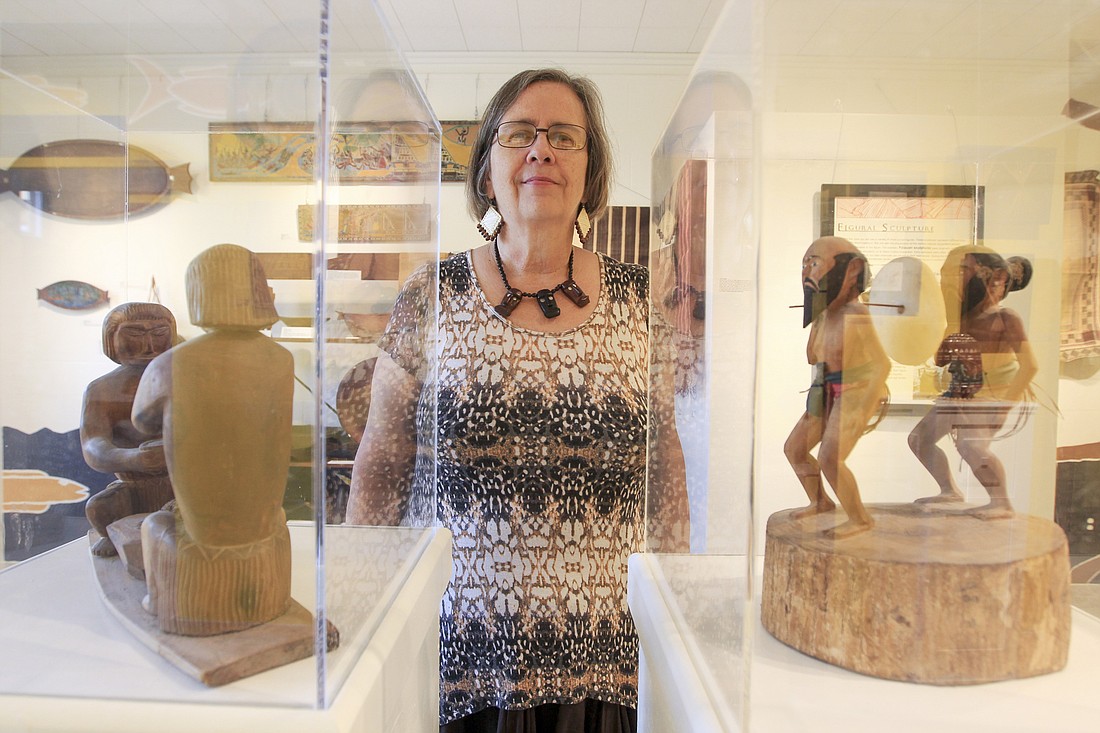- April 19, 2024
-
-
Loading

Loading

There’s a whole other part of the world ready to be explored, and it sits just outside of downtown Winter
Park.
In the galleries at the Albin Polasek Museum and Sculpture Gardens, the culture and wonder of a far-away land is on full display and the atmosphere fully immerses you into the exhibit.
Hand-sculpted wood carvings of people and animals sit within glass casings, while large wood story boards hang from the walls.
The walls of the gallery itself are painted in bright colors that reflect the palettes found in many of the 400-odd pieces that make up Island Objects: Art and Adaptation in Micronesia — a showcase featuring part of the collection of local anthropologist Barbara Wavell.
“You’ll ask some collectors and they’ll go, ‘Oh I didn’t even remember that I had this,’ or ‘I got this and put it away’ — I remember everything,” Wavell said. “I record who I got it from, what were the circumstance under with which it was got, and if I get another similar thing I know that, ‘Hey, that was probably from the same period,’ because things change over time, so I can use that to date objects. After a while, you build information.”
This exhibit showcases only a portion of Wavell’s full collection, which features more than 1,200 items that date between the 1800s to present. Most of the collection is post-World War II.
It was her incredible attention to detail and deep desire to learn that drove Wavell to begin diving into collecting Micronesian artifacts. During the early stages of her career, she was collecting wooden pieces without knowing what it was, and from where it originated.
Although she was born in England, Wavell grew up in Winter Park and attended Rollins College in the 1970s.
During her years at Rollins, Wavell picked up the hobby of collecting wood carvings from around the world, before going on to graduate school to study cultural anthropology at the State University of New York at Binghamton.
“I would go to the flea markets, and that would be one of the things I would look for, because I really liked them,” Wavell said. “One day, I got a carved board and a carved squatting figure, and I didn’t know really where they were from so I started researching — by this time, I was getting my master’s.
“As I started to research it, I realized there wasn’t that much information available, so I started to look into it and gather all of this information,” she said.
From there, Wavell’s passion for Micronesia became a full-time job of research and collecting whatever she could possibly find.
Wavell even found her way to Micronesia — a subregion of Oceania comprised of thousands of small islands located in the western Pacific Ocean — in 2004 for the Festival of Pacific Art.
“As I started to research it, I realized there wasn’t that much information available, so I started to look into it and gather all of this information."
- Barbara Wavell
For a month, Wavell immersed herself in the colorful culture and people she had long been studying.
“It was very dream-like — it was amazing,” Wavell said with a grin. “The Festival of Pacific Art — it’s sort of like the Olympics. They have groups with matching costumes from each island area, and it also includes Polynesia and Melanesia.They have a big parade, they have dances from every area, and they have handicrafts, so I was able to collect a lot of crafts from different islands.”
Being able to observe and document life on the islands in-person, even if for such a short time, gave Wavell the first-hand experience she always had wanted.
Although Wavell said there is still a lot to research and take in, it is this aspect of constant learning and epiphanies she said has helped keep her interest piqued as she continues to collect everything from hand-woven fans to handmade weapons carved from wood and stone.
“The more you even look at objects and how they’re made, and how the way they’re made changes over time, you learn a lot about the process of globalization, the influences of other cultures — it’s really complicated,” Wavell said. “And every object that you get is from a specific point in history.” historyhistorical context.”